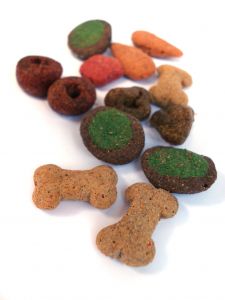
Food Allergies in Dogs

Food allergies account for about 10% of all the allergies seen in dogs and cats. It is the third most common cause after flea bite allergies and atopy (inhalant allergies).
With the advent of lamb and rice diets many people feel that they are preventing or treating food allergies. The fact is that nothing could be farther from the truth.
The entire process of a pet being sensitized to a particular agent in food and the complicated antibody response that occurs in the intestinal tract in pets with food allergies are not very well understood.
Despite our lack of understanding of the actual disease process, there are many things that we do know including the symptoms, how to diagnose food allergies, and also how to treat them.
Food allergies affect both dogs and cats. Unlike atopy, there is no strong link between specific breeds and food allergies. Food allergies affect both males and females and neutered and intact animals equally.
They can show up as early as five months and as late as 12 years of age, though the vast majority of cases occur between 2 and 6 years. Many animals with food allergies also have concurrent inhalant or contact allergies.
Food allergy or intolerance
There is a distinction that needs to be made between food allergies and food intolerances. Food allergies are true allergies and show the characteristic symptoms of itching and skin problems associated with canine and feline allergies. Food intolerances can result in diarrhea or vomiting and do not create a typical allergic response. Food intolerances in pets would be similar to people that get diarrhea or an upset stomach from eating spicy or fried foods. Fortunately, both food intolerances and allergies can be eliminated with a diet free from offending agents.
Common food culprits
Several studies have shown that some ingredients are more likely to cause food allergies than others. In order of the most common offenders in dogs are beef, dairy products, chicken, wheat, chicken eggs, corn, and soy. As you may have noticed, the most common offenders are the most common ingredients in dog foods. This correlation is not a coincidence. While some proteins might be slightly more antigenic than others, many proteins are similar in form and the incidence of allergic reactions are probably associated with the amount of exposure.
For example, pet foods have historically been made up of beef, chicken, corn, and wheat. In an effort to combat food allergies, several companies produced a diet made of lamb and rice. There was nothing special about lamb and rice diets except those two ingredients were normally not present in pet foods. Animals had not eaten lamb or rice before, and therefore, had not developed an allergy to it yet. If the main ingredients in pet food become lamb and rice, then it would stand to reason that the most common problem foods could become lamb and rice. The determinant of whether a food is likely to cause a food allergy or not is based on the structure and size of the glycoprotein in the food. In addition, many lamb and rice-based foods contain many other ingredients, and if the animal has a food allergy to any of them, this lamb and rice food will do nothing to treat the food allergy. In addition, while many people criticized and blamed preservatives and flavorings as a source of food allergies, studies have shown that they are not the causes, and while we may not have justifiable health concerns about preservatives, food allergies is not one of them.
Clinical Signs (Symtoms)
The symptoms of food allergies are similar to those of most allergies seen in dogs and cats. The primary symptom is itchy skin. Symptoms may also include chronic or recurrent ear infections, hair loss, excessive scratching, hot spots, and skin infections that respond to antibiotics but reoccur after antibiotics are discontinued. There is evidence that dogs with food allergies may sometimes have an increased incidence of bowel movements. One study showed that non-allergic dogs have around 1.5 bowel movements per day where some dogs with food allergies may have 3 or more per day.
It is difficult to distinguish an animal suffering from food allergies from an animal suffering from atopy or other allergies based on physical signs. However, there are a few signs that always make me suspect food allergies. One of these, is a dog with recurrent ear problems, particularly yeast infections. Another, is a very young dog with moderate or severe skin problems. A third tip off, is if a dog suffers from allergies year-round or if the symptoms begin in the winter. And the final clue, is a dog that has very itchy skin but does not respond to antihistamines or steroid treatment.
Diagnosis
The diagnosis for food allergies is very straightforward. But due to the fact that many other problems can cause similar symptoms and that many times animals are suffering from more problems than just food allergies, it is very important that all other problems are properly identified and treated prior to undergoing diagnosis for food allergies. Atopy, flea bite allergies, intestinal parasite hypersensitivities, sarcoptic mange, and yeast or bacterial infections can all cause similar symptoms as food allergies. Once all other causes have been ruled out or treated, then it is time to perform a food trial.
Elimination diets and provocative testing
Elimination diets and provocative testing: A food trial consists of feeding an animal a novel food source of protein and carbohydrate for 12 weeks. A novel food source would be a protein and carbohydrate that the animal had never eaten before. An example would be rabbit and rice, or venison and potato, or duck and rutabagas. These are homemade diets but there are several commercial diets available on the market. Special Foods produced by Hill's and Purina, and a food named EXclude are used by many dermatologists. Regardless of the diet used, it must be the only thing the animal eats for 12 weeks. This means no treats; absolutely nothing but the special food and water. Young growing pets have special dietary needs and a homemade diet that only contains one protein and one carbohydrate with no multivitamin or fatty acid may not be suitable even for only twelve weeks. For puppies undergoing a food trial, a balanced commercial diet like the ones listed above is recommended.
Veterinarians used to recommend that a pet only needed to be placed on a special diet for 3 weeks, but new studies show that in dogs, only 26% of those with food allergies responded by day 21. However, the vast majority of pets responded by 12 weeks. Therefore, it is very important to keep the pet on the diet for the entire 12 weeks. If the dog shows a marked reduction or elimination of the symptoms, then the animal is placed back on the original food. This is called 'provocative testing' and is essential to confirm the diagnosis. If the symptoms return after going back on the original diet, the diagnosis of a food allergy is confirmed. If there has been no change in symptoms but a food allergy is still strongly suspected, then another food trial using a different novel food source could be tried.
We must reiterate that placing a dog on a commercial lamb and rice formula dog food is not an acceptable way to diagnose or treat food allergies. Lamb and rice are no longer considered novel food sources and most commercial lamb and rice diets also contain wheat, egg, corn, or other ingredients that can be the cause of the food allergy. Despite the implication by dog food companies to the contrary, these foods do not prevent food allergies nor are they considered adequate for diagnosis. While these diets may provide adequate nutrition, they are not a substitute for a true, novel protein source diet.
Blood Testing
Many owners and veterinarians attempt to look to other tests to diagnose food allergies. Blood tests such as the RAST test or the ELISA test can be performed to screen for food allergies. In addition, intradermal skin testing could also be performed. Despite the fact that these tests are routinely performed and used as a diagnostic aid, there is no evidence that blood tests are accurate for the diagnosis of food allergies. Veterinary dermatologists insist that there is no merit in these tests whatsoever in the diagnosis of food allergies.
The only way to accurately diagnose food allergies is with a food trial as detailed above. While the intradermal skin testing is excellent for diagnosing atopy (inhalant allergies) it is ineffective for food allergies. While the ELISA and to a lesser extent the RAST test can be used to help in the diagnosis of atopy, they have no benefit in diagnosing food allergies. In our review of all the current books and articles on veterinary dermatology and allergies, we could not find a single dermatologist that endorsed anything other than the food trial as an effective diagnostic aid. If you want to diagnose and treat food allergies you must do a food trial.
Treatment
Once we determine a positive diagnosis, then the treatment is very straightforward. The owner of the animal has two choices. They can choose to feed the animal a special commercially prepared diet or a homemade diet.
If the owner chooses to feed the homemade diet, then they can periodically challenge the pet with new ingredients and determine which ingredients are causing the food allergy. For example, if the animal's symptoms subsided on a diet of rabbit and potatoes, then the owner could add beef to the diet for two weeks. If the animal showed no symptoms, then they could then add chicken for two weeks. If the animal began to show symptoms, then it could be assumed that chicken was one of the things the pet was allergic to. The chicken could be withdrawn and after the symptoms cleared up, a different ingredient could be added and so on until all of the offending ingredients were identified. A diet could then be formulated that was free of the offending food sources.
If homemade diets are used, it is essential that they be balanced, with correct amount of ingredients, vitamins, and minerals.
- All About German Shepherd Puppies
- Pet Disease and Allergies
- Hips and Elbows
- German Shepherd Dog Anatomy
- What is Schutzhund
- German Shepherd Behavior
- Quick Tips On German Shepherds
- Our Show Dogs










